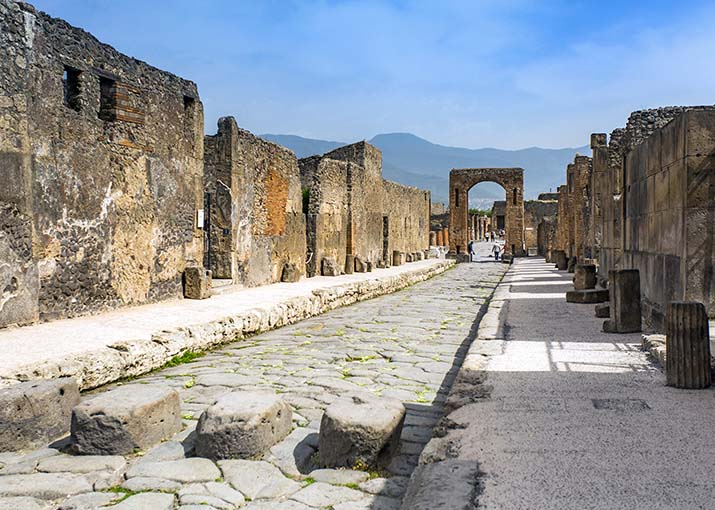I’ve always cherished the idea of traversing through cities on foot. Naples, with its rich tapestry of history, bustling streets, and iconic landmarks, beckons explorers to embark on a journey like no other.
Pompeii
As I stood before the ancient ruins of Pompeii, I couldn’t help but feel a sense of reverence for the city’s enduring legacy. Frozen in time by the catastrophic eruption of Mount Vesuvius in 79 AD, Pompeii stands as a testament to the fragility of human existence and the inexorable forces of nature. Walking through its labyrinthine streets, I felt a profound connection to the past, as if the echoes of ancient life still reverberated within its crumbling walls.
Upon arrival, I was greeted by the sight of knowledgeable archaeologists leading guided tours, their passion for Pompeii’s history evident in every word they spoke. Eager to delve deeper into the city’s secrets, I joined one of these tours, eager to uncover the mysteries hidden beneath the layers of volcanic ash. As we wandered through the streets, our guide regaled us with tales of Pompeii’s glory days, painting a vivid picture of life in this ancient metropolis.
For those who prefer to explore at their own pace, audio guides are available, providing a wealth of information about Pompeii’s landmarks and historical significance. With headphones in place, I set off on my own adventure, allowing the voices of the past to guide me through the ruins. As I wandered from one crumbling building to the next, I marveled at the ingenuity of Pompeii’s inhabitants, whose homes and public buildings still bore testament to their craftsmanship and artistry.
Whether guided by expert archaeologists or navigating the ruins solo with the aid of audio guides, exploring Pompeii is an experience that transcends time. It’s a journey back to a bygone era, where every stone tells a story and every step brings you closer to the heart of this ancient city.
Pros:
- Immersive historical immersion
- Well-maintained archaeological site
- Informative guided tours

Cons:
- Crowded during peak seasons
- Limited accessibility for mobility-impaired individuals
Geographical Location:
Pompeii lies approximately 25 kilometers southeast of Naples, making it an accessible day-trip destination.
Route:
From Naples, one can board a regional train from Napoli Centrale to Pompei Scavi-Villa dei Misteri station, followed by a brief walk to the archaeological site.
Discounts:
Discounted admissions are often available for students and seniors, so carrying relevant identification is advisable.
Booking Platform:
Tickets can be procured on-site or in advance through the official Pompeii website, which furnishes detailed information on opening hours and special exhibitions.
Stepping into the ancient streets of Pompeii transported me back in time. The level of preservation was staggering, and the guided tour provided invaluable context to the ruins’ significance. Despite the crowds, the magnitude of history encapsulated within Pompeii’s embrace rendered it an indelible experience.
Mount Vesuvius
As I gazed up at the towering silhouette of Mount Vesuvius, its imposing presence dominating the Naples skyline, I couldn’t help but feel a mixture of awe and trepidation. This iconic volcano, both majestic and ominous, serves as a stark reminder of the cataclysmic events that unfolded nearly two millennia ago.
Eager to experience the raw power of nature firsthand, I embarked on the exhilarating journey to hike to the volcano’s crater. At the mountain’s base, I was greeted by local guides, seasoned experts whose knowledge of Vesuvius’ terrain and history was unparalleled. With their guidance, I felt reassured as I prepared to undertake the ascent, knowing that my safety was in capable hands.
Before beginning our trek, we gathered at the base for an informative briefing, where exhibits and presentations provided insights into Vesuvius’ geological and historical significance. As I listened to the rumblings of the volcano’s past eruptions and learned about its impact on the surrounding landscape, I gained a newfound appreciation for the forces at play beneath the earth’s surface.
With anticipation coursing through my veins, I set off on the hike, each step bringing me closer to the summit and to the heart of Vesuvius itself. As we ascended the rugged terrain, the air grew thick with excitement, mingled with the scent of sulfur emanating from the volcano’s vents. Along the way, our guides regaled us with tales of Vesuvius’ tumultuous history, from its fabled eruptions to its role as a backdrop for ancient legends.
Finally, after hours of trekking, we reached the crater’s edge, our efforts rewarded with a breathtaking panorama of the surrounding landscape. From this vantage point, I could see the sprawling city of Naples below, its streets and buildings stretching out towards the azure waters of the bay. It was a moment of exhilaration and reflection, as I stood on the precipice of history, marveling at the raw power and beauty of Mount Vesuvius.
Descending from the summit, I couldn’t help but feel a profound sense of gratitude for the opportunity to commune with nature in such a profound way. Hiking to Mount Vesuvius’ crater had been an adventure unlike any other, a thrilling blend of adrenaline and enlightenment that left an indelible mark on my soul.
Pros:
- Breathtaking panoramic vistas
- Exhilarating hiking experience
- Educational insights into volcanic activity
Cons:
- Weather-dependent visibility
- Challenging terrain
Geographical Location:
Mount Vesuvius lies approximately 9 kilometers east of Naples, commanding views of the bay.
Route:
Bus services ferry visitors from Naples to the Vesuvius National Park entrance, from where the ascent to the crater commences.
Discounts:
Combination tickets, encompassing Pompeii and Mount Vesuvius admissions, are often available at reduced rates.
Booking Platform:
Tickets can be secured on-site or through specialized online platforms catering to tours and excursions.
Ascending Mount Vesuvius was a visceral adventure. The rugged terrain, coupled with the volcano’s tumultuous history, infused the journey with a palpable sense of excitement. Gazing into the crater’s depths was both humbling and exhilarating, offering a unique perspective on nature’s forces.
Naples Underground
As I wandered through the bustling streets of Naples, I couldn’t shake the feeling that there was something more, something hidden beneath the surface waiting to be discovered. Little did I know that beneath the city’s facade lay a clandestine realm, a labyrinth of tunnels and catacombs known as Naples Underground, just waiting to be explored.
With a sense of anticipation coursing through my veins, I made my way to one of the entrance points to Naples Underground. As I descended into the depths below, I was enveloped by a sense of mystery and intrigue, the echoes of centuries past whispering through the stone walls.
Guided tours led by knowledgeable locals awaited me, promising to illuminate the significance of Naples Underground and unveil its secrets. As our group ventured deeper into the subterranean maze, our guide regaled us with tales of the city’s history, from its ancient origins to its more recent role as a refuge during times of war.
The tunnels themselves were a marvel to behold, their walls adorned with graffiti dating back centuries, each inscription a silent testament to the lives that once passed through these underground passages. As we explored further, we encountered remnants of ancient aqueducts and cisterns, marveling at the ingenuity of those who had built them so many years ago.
For those with more specialized interests, Naples Underground offered a variety of themed tours catering to different aspects of the city’s subterranean history. Whether delving into the intricacies of the city’s aqueduct system or exploring the wartime shelters that had provided sanctuary to Naples’ residents during World War II, there was something for everyone to discover beneath the streets of Naples.

As our tour came to an end and we ascended back to the surface, I couldn’t help but feel a sense of awe at the hidden world that lay beneath the city’s bustling streets. Naples Underground had offered me a captivating odyssey through the city’s subterranean history, a journey that had left me with a newfound appreciation for the rich tapestry of Naples’ past.
Pros:
- Unparalleled underground exploration
- Engaging guided tours
- Respite from summer heat
Cons:
- Limited accessibility for claustrophobic or mobility-impaired individuals
- Not entirely suitable for young children
Geographical Location:
Naples Underground sprawls beneath the city’s historic core, with entrances dispersed throughout.
Route:
Various access points grant entry into Naples Underground, with guided tours departing from designated rendezvous spots.
Discounts:
Discounted rates are typically extended to students, seniors, and groups.
Booking Platform:
Tickets can be acquired on-site or in advance via Naples Underground’s official website, furnishing comprehensive tour details and schedules.
Exploring Naples Underground felt akin to unearthing a clandestine world concealed beneath the city’s facade. The winding tunnels resonated with echoes of history, offering poignant glimpses into Naples’ multifaceted past. The guided tour was both informative and immersive, shedding light on oft-overlooked facets of the city’s narrative.
Castel dell’Ovo
Perched on the shores of the Bay of Naples, Castel dell’Ovo exudes an aura of medieval splendor. Its vantage point affords sweeping vistas of the cityscape and the azure expanse beyond.
Primarily a historical site and public park, Castel dell’Ovo occasionally hosts cultural events and exhibitions. Guided tours unravel the castle’s storied past for eager visitors.
Pros:
- Stunning panoramic views
- Tranquil ambiance
- Photographic opportunities aplenty
Cons:
- Limited interior access
- Occasional closures for private events
Geographical Location:
Castel dell’Ovo rests on the islet of Megaride, tethered to the mainland by a causeway in the Bay of Naples.
Route:
Easily accessible from Naples’ historic center, either on foot or via public transit. Ferries also ply routes from neighboring locales.
Discounts:
While specific discounts for Castel dell’Ovo may be scant, combination tickets could encompass multiple Naples attractions.
Booking Platform:
Tickets can be procured on-site at the castle entrance.
Exploring Castel dell’Ovo evoked a sense of enchantment. The castle’s silhouette against the bay’s backdrop was nothing short of mesmerizing, and the panoramic views from its ramparts were breathtaking. While interior access was limited, meandering through the grounds proved to be a tranquil respite from the city’s hustle.
Naples, with its amalgamation of history, culture, and natural splendor, beckons intrepid souls to traverse its streets and landmarks. Whether navigating the ancient ruins of Pompeii, scaling the heights of Mount Vesuvius, delving into Naples Underground’s depths, or basking in the serenity of Castel dell’Ovo, each landmark offers a distinct facet of Naples’ allure. Additionally, attractions such as the Capodimonte Museum and Park provide deeper insights into the city’s artistic and cultural legacy. Armed with curiosity and a spirit of adventure, exploring Naples on foot promises an odyssey replete with awe and wonder, leaving an indelible imprint on the soul.



